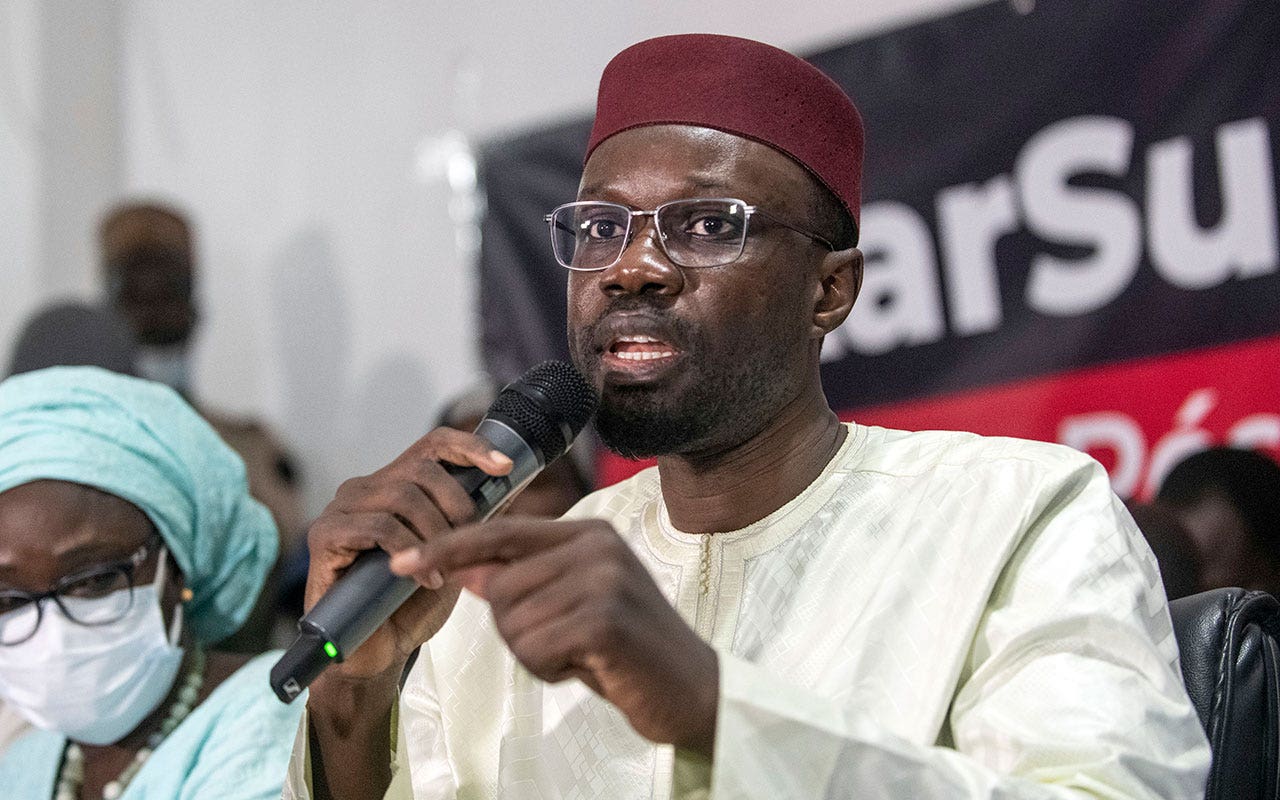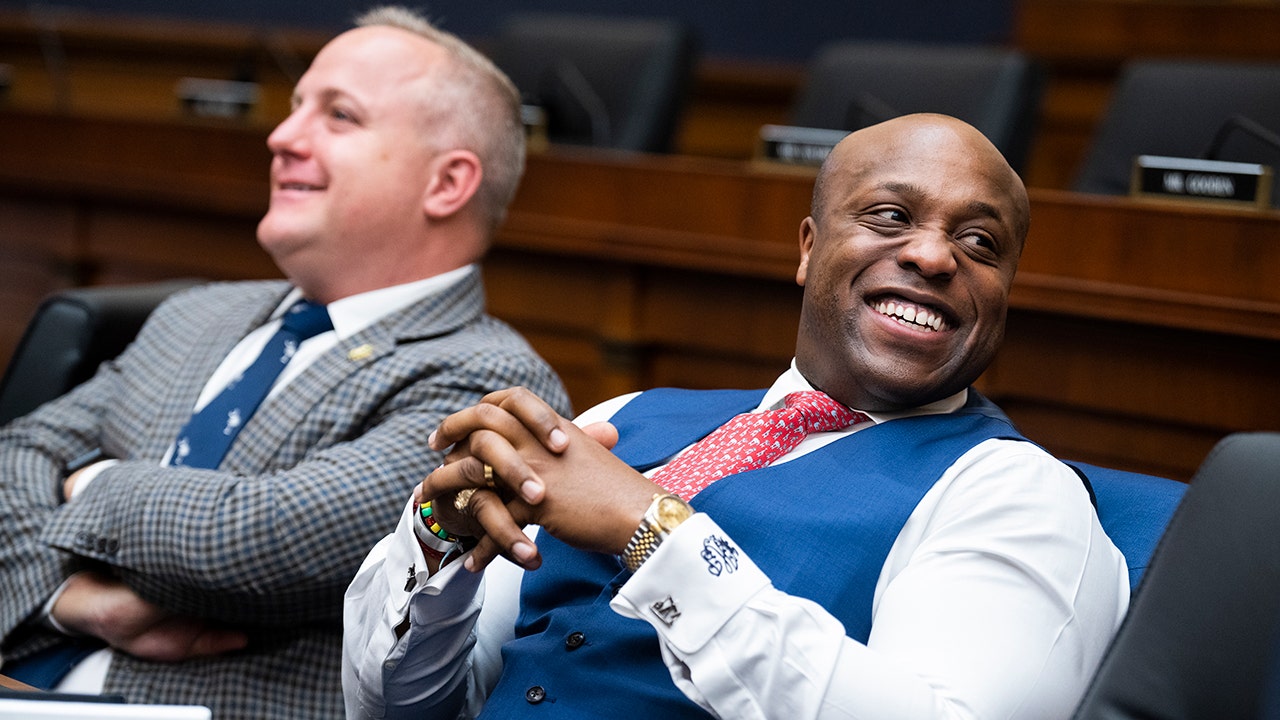Oklahoma
Lucas notes ‘capital-starved’ Oklahoma in Financial Services bid

Rep. Frank D. Lucas knows he’s the likely underdog in the now four-man race to replace Patrick T. McHenry as the top Republican on the House Financial Services Committee, but he isn’t letting that stop him.
The Oklahoma Republican jumped into the race this month, saying it’s the logical conclusion of his nearly 30-year panel tenure. He brings an emphasis on traditional banking policy issues and a cautious tone on cryptocurrency to the race. And he said he’s facing off against three of his “very favorites,” Reps. Andy Barr of Kentucky, French Hill of Arkansas and Bill Huizenga of Michigan, all current subcommittee chairs with strong fundraising records.
“In my career as a legislator, in my career as a candidate, I’ve often been underestimated by lots of people. I don’t mind that. People can underestimate you as long as you overperform,” Lucas said in an interview. “We’ll see if I’m capable of overperforming one more time.”
Lucas pointed out that the race, whose outcome will be determined by the Republican Steering Committee after the election in November and the conference picks its leadership, is a long way from the finish line. He faces strong opponents, but anything could happen between now and then.
“Honestly, who knows at this moment what that world will look like?” he said.
In the meantime, Lucas, who has chaired the House Agriculture Committee and now has the House Science, Space and Technology gavel, is pitching himself as someone with experience at the helm of committees, mentoring younger members and working across the aisle when consensus is possible.
‘Maintain the fundamentals’
A fifth-generation Oklahoman who grew up on a farm that has been in his family since 1912, Lucas joined the Financial Services Committee during his first term, back when it was called the Banking and Urban Affairs Committee.
He said he was drawn to the panel because of its jurisdiction over the cost and availability of capital, a key issue for his district, which covers about 34,000 square miles across Oklahoma’s western half.
“I’m an ag district at home. I’m an energy district. I’m Main Street. I’m manufacturing,” Lucas said. “All capital-intensive industries in a capital-starved state.”
Lucas said he would emphasize lending and capital — bread-and-butter banking issues — if he gets the gavel, something of a departure from the panel’s previous two chairs.
McHenry, R-N.C., the current chairman, who is retiring at the end of his term, has a reputation for tackling new technology and emerging issues, most notably regulating cryptocurrency and updating financial data privacy protections.
The panel’s top Democrat, Rep. Maxine Waters of California, used her time as chair to shine a light on housing issues.
“There’s a tendency in Congress to want to play with whatever the shiniest, brightest new toy is. But if you don’t maintain the fundamentals in, call it your jurisdiction or call it the economy, then you’re setting yourself up for future problems,” Lucas said. “I might have more of a focus on the traditional issues: cost of and the availability of capital. It doesn’t mean that I’m going to ignore problems or I’m going to ignore new facets of the industry that evolve.”
The disappearance of community and regional banks is a big concern, Lucas said, adding that it’s an issue where Republicans and Democrats can find common ground.
“In the traditional banking department, by policy intentionally or unintentionally, the number of actual chartered banks out there is collapsing dramatically. I think we should have more competition in the financial services realm, not less,” he said.
The number of federally insured banks and savings institutions was cut roughly in half from 9,354 to 4,706 banks between 2002 and 2022, according to Federal Deposit Insurance Corporation data that predates some prominent 2023 bank failures and the ensuing spike in deposit flight to the biggest banks.
Lucas is up against an opponent who has direct experience in the banking sector. Hill was the founder, chairman and CEO of Little Rock, Ark.-based Delta Trust & Banking Corp. The sale of Delta Trust in 2014 illustrates a major reason behind the decline in smaller banks: mergers and acquisitions.
The decline of local banks has implications for Lucas’ agriculture-dependent district. About 77 percent of agricultural loans and more than half of small-business loans originate with community banks, according to a 2015 study from the Harvard Kennedy School of Government.
Lucas said he could work with Waters, whether she’s chair or ranking member, to find common ground on encouraging community banking, especially to increase the diversity among ownership of smaller banks.
“We’re going to disagree on 90 to 95 percent of the policy issues. But we’re not going to be, I believe, disagreeable,” Lucas said of Waters. “And we’re going to work — I believe in whichever role things are found out to be — on achieving consensus on the issues that reflect my first goal: the cost and the availability of capital.”
The committee could face even more urgent business in the banking sector next Congress if the commercial real estate market continues to deteriorate and banks are left holding the bag, Lucas said.
Regional banks, the same banks whose decline already poses a concern for Lucas, are more exposed to commercial real estate than their bigger counterparts.
‘Crypto is still the Wild West’
Lucas acknowledged the committee will have to address cryptocurrency regulation early in the 119th Congress if McHenry doesn’t get his package across the finish line by the end of the year.
“Crypto’s important. It’s real. It is with us. It’s not going away,” Lucas said. “And we need to have rules and regulation structure. We also need to be mindful about ever-changing technology.”
Like other Republicans on Financial Services, Lucas says Congress must pass legislation for the regulation of cryptocurrency, contrasting with top committee Democrats who say the Securities and Exchange Commission already has the authority to oversee the space.
But Lucas is more wary of cryptocurrency than many GOP colleagues.
“Crypto is still the Wild West,” he said, a comment similar to statements by SEC Chairman Gary Gensler, who has sought to bring the cryptocurrency sector to heel.
“I have constituents who come to my public town hall meetings who are very enthusiastic about crypto because they view it as a way to move their resources, their wealth, their money, however you want to describe it, around in a way that neither the banks, nor the Treasury, nor the IRS can keep track of,” Lucas said. “That same principle also creates opportunities for nefarious people. So there has to be some form of regulation.”
Advances in computing could also pose security risks to cryptocurrencies, which rely on encryption to function, Lucas added.
Underdog
Lucas is a relatively late entrant in the race. He is the longest-serving Republican on the panel and second only to McHenry in seniority. But as chairman of the Science, Space, and Technology Committee, Lucas was barred from leading a Financial Services subcommittee this Congress. He also lags well behind his three rivals in campaign fundraising.
Lucas has raised $835,700 so far this cycle, according to Federal Election Commission data. He raised $1.5 million for the 2022 midterms, less than half the amount each of his opponents raised last cycle. Heading into November, Barr leads the pack on fundraising with $2.6 million, followed by Hill with $2.2 million and Huizenga with $1.9 million.
Lucas dismissed his anemic fundraising numbers.
“The resources follow the position,” he said. “Now that I’m in the race, we’ll see how that affects the fundraising mixture for all of us. But I’m not concerned about that. Whoever prevails will meet their obligations at the NRCC [National Republican Congressional Committee].”
The Steering Committee will consider a range of variables in picking McHenry’s successor, including seniority, regional balance among committee leaders across the conference, legislative track record and relationships with leadership.
But fundraising numbers are crucial, and the Financial Services panel is traditionally seen as a plum opportunity given the deep pockets of the sectors it oversees.
“I have faith in the people who know us well to make a wise decision,” Lucas said. “And those kinds of people don’t respond to contributions. They understand what’s at stake.”

Oklahoma
Oklahoma wheat much improved in 2024

Wheat producers in Southwest Oklahoma are hoping for one more good rain and a crop much better than they’ve seen in several years.
Across the state, conditions are mixed as farmers near harvest.
“We’ve just started crop tours,” says Oklahoma State University Extension Small Grains Specialist Amanda de Oliveira Silva, Stillwater.
“Wheat near Altus looks good,” Silva says. “We’ve seen some stripe rust that came in earlier than usual, but overall the crop looks good. Wheat in the Northwestern part of the state does not look good. Some fields started off good but are going backwards. It’s dry; they need rain.”
‘Hit or miss’ wheat conditions
Silva says wheat in West Oklahoma, near Sentinel and some other parts of the state, is in a “hit or miss” situation. Wheat that received the latest rains looks good, but there is some that missed a lot of rain, so we see short wheat, thinner stands, and some damage from early-season stripe rust infestation. Overall, I think we are in a much better shape than we were the past two years, but we could still use some rain, especially on the West, the Northwest, and North Central areas.”
Stripe rust: conditions that favor wheat growth also favor stripe rust. (Photo by Amanda De Oliveira Silva)
She says acres for harvest likely will be down from earlier expectations as there were some people that had the field disastered out or are grazing out the wheat. I thought in early spring, we could have a bumper crop, but as conditions get drier in some places, yields will not be as high as we thought. Next week, at the Oklahoma Grain and Feed Association annual meeting, we will have harvest estimates from each region.
“We’re better than last year, but we’re off from a month ago as conditions get drier and storm chances with possible hail damage increases in some regions.”
Stripe rust
Stripe rust came in earlier than usual at around wheat jointing stage, Silva says.
“Farmers sprayed fungicide early for stripe rust. I’ve heard that as much as 90% of the wheat in Southwest Oklahoma was sprayed for stripe rust. That’s atypical, but we had a lot of it.
“A big issue was that most of the wheat varieties grown in Oklahoma do not have seedling resistance against stripe rust, they only have the adult plant resistance (and not all varieties have the adult plant resistance either). So, what happens is that the adult plant resistance genes only get turned on after flag leaf stage. As stripe rust came in earlier than that, the genes were not activated and could not protect the plant.

Resistance comparison: The plot on the left is damaged by stripe rust next to a plot with a variety showing better resistance. (Photo by Amanda De Oliveira Silva)
“We have seen a lot of damage in Southwest Oklahoma. Some varieties have performed better than others.”
Conditions that favor good wheat growth also favor rust, she adds.
English grain aphids
OSU Extension IPM Coordinator Ashleigh Faris says she’s seen some English grain aphids in some areas. “They are not typically economically important in Oklahoma, but they can transmit the barley dwarf virus, so it is worth paying attention to them in the field.
“The other ones we’re seeing are the bird cherry oat aphids. Numbers are low though, and every time I see these aphids, I’m also seeing a lot of natural enemies. So we’re seeing lady beetle larvae and lady beetle adults, and they’re all pretty voracious.”
Faris says considering crop maturity and natural predation, growers shouldn’t need to spray these pests. “The good news is the natural enemies are helping to manage the aphid populations.
“Some areas are still holding up yield potential,” Silva says. “Wheat at Apache, in South Central Oklahoma, looks great. Chickasha looks great.
“I think the main lesson for producers this year will be stripe rust resistance. We’re seeing one of the heaviest stripe rust pressures we have seen in a long time. Now, as it starts getting drier and drier, that’s another story.”
Silva says that if the weather conditions remain warm, many wheat farmers will harvest early, but cool temperatures should help the wheat slowly down and properly fill the grain. Southwest Oklahoma farmers are especially excited. They have not seen a crop like this in a long time. We all need a win.”
Oklahoma
Oklahoma State Lands Xavier Transfer Center

Oklahoma State has added more size for next season.
Xavier transfer Abou Ousmane announced on social media Tuesday that he is committing to OSU. Going into his fifth season, Ousmane offers the Cowboys more experience.
Ousmane played a key role at Xavier last season, starting 29 of 34 games. However, his production took a hit when he moved to the Big East.
In his only year at Xavier, Ousmane averaged 6.7 points, 6.4 rebounds and 1.4 blocks. With the Musketeers, he posted four double-doubles and had 13 games with at least two blocks.
Before transferring to Xavier, the 6-foot-10 big man spent his first three seasons at North Texas. He had his best campaign in his final season there, making the All-Conference USA third team.
As a junior, he averaged 11.1 points, six rebounds and 1.3 blocks. In 2023, he helped North Texas post a 31-7 record and win the NIT.
Although Ousmane only played one game of the Mean Green’s NIT run, his impact that season earned him interest from a number of larger schools. However, that interest was not only because of his performance that season.
In 2021-22, Ousmane averaged 10.2 points and 5.9 rebounds. In his final two seasons at North Texas, Ousmane started all 66 games he played.
Before that, he played a limited role on North Texas’ NCAA Tournament team in 2021.
After OSU fired seven-year coach Mike Boynton, many key players entered the transfer portal. Athletic director Chad Weinberg chose Steve Lutz to lead the program into next season.
Ousmane is the latest addition to an OSU team that will look vastly different next season. Alongside the Cowboys’ other additions, Ousmane will look to help OSU back to the NCAA Tournament for the first time since 2021.
Want to join the discussion? Like AllPokes on Facebook and follow us on Twitter to stay up to date on all the latest Cowboys news. You can also meet the team behind the coverage.
Oklahoma
Governor Signs Strengthen Oklahoma Homes Act Into Law

Oklahoma Governor Kevin Stitt has signed into law Monday a bill, which aims to provide financial grants to construct or retrofit homes, making them more resilient against the destructive forces of tornadoes, windstorms and hail.
Under the new law, known as the Strengthen Oklahoma Homes Act, grants will be made available by the Oklahoma Insurance Department (OID) to residential property owners who meet specific eligibility criteria.
These criteria include an owner-occupied, single-family primary residence. The grants are intended to help homeowners achieve safety standards outlined by the Insurance Institute for Business and Home Safety (IBHS).
Insurance Commissioner Glen Mulready praises the Oklahoma Legislature and the Governor for approving this measure and the difference it will make to assist Oklahomans in fortifying their homes against natural disasters.
“The recent destruction we have seen across our state is a grave reminder why this legislation will be so important to help Oklahomans rebuild and protect their homes from severe weather,” said Mulready. “I am grateful to legislative leaders and the Governor for understanding our goal to help Oklahoma consumers reduce their homeowners insurance rates and fortify their homes against mother nature.”
The Strengthen Oklahoma Homes Act will establish a grant program aimed at assisting homeowners in reinforcing their roofs with impact-resistant materials that meet FORTIFIED standards set by the IBHS. These funds will enable consumers to construct or retrofit their homes with impact-resistant shingles and other enhancements. Additionally, many insurance companies offer reduced premiums for homes with such modifications.
The new grant program created by the law will be in development through the end of the year, with the first grants going out in 2025.
Source: Oklahoma Insurance Department
Topics
Oklahoma
Was this article valuable?
Here are more articles you may enjoy.
The most important insurance news,in your inbox every business day.
Get the insurance industry’s trusted newsletter
-

 Politics1 week ago
Politics1 week agoHouse Dems seeking re-election seemingly reverse course, call on Biden to 'bring order to the southern border'
-

 Politics1 week ago
Politics1 week agoFetterman says anti-Israel campus protests ‘working against peace' in Middle East, not putting hostages first
-

 News1 week ago
News1 week agoUS man diagnosed with brain damage after allegedly being pushed into lake
-

 World1 week ago
World1 week agoGaza ceasefire talks at crucial stage as Hamas delegation leaves Cairo
-

 World1 week ago
World1 week agoStand-in Jose Raul Mulino wins Panama presidential race
-

 World1 week ago
World1 week agoTech compliance reports, Newsletter
-

 News1 week ago
News1 week agoColumbia University cancels its main commencement ceremony after weeks of turmoil
-

 News1 week ago
News1 week agoCompass Direct LLC’s 2024 Registration in North Carolina



















